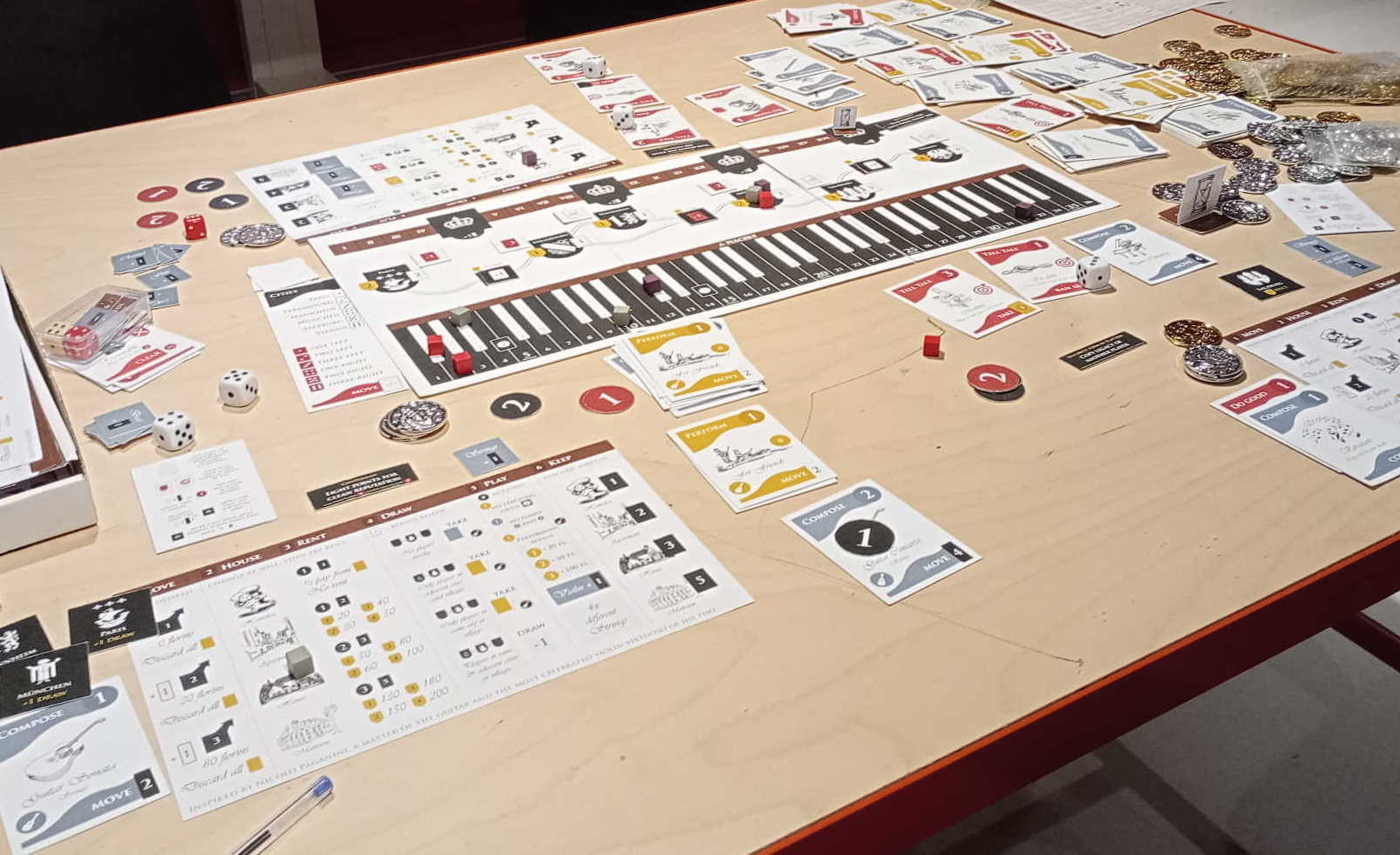

Board game around composers like Wolfgang Amadeus Mozart, with players composing, teaching and performing for the most points.
It was originally intended as a gateway game; easy to get into for new board gamers, but keep experienced gamers interested as well. It ended up more complex with some added mechanics, but is still very playable for players new to board gaming.
Over sixty playtests later, another at least five "solo" tests with every character board and 15+ tests with the solo mode, this game is now out being blind tested.
back to homepageChose the cities and decided on two scoring tracks with a rounds track just above it. At first the income/money track was at the top of the board. Cards involved separate decks for the three different types of cards.
To be able to create compositions, players have to teach or perform to earn florins for rent, then get better housing for more productivity. The core mechanics as designed early on haven't changed much.
On top of that there's interactivity by spreading rumors, reducing opponents' number of cards to draw, taking away their income cards or kicking them out of cities of prestigious royal events.
Money was separated with coins. Graphical redesign of the cities and the rounds track moved to the top. Vienna of course should be "Wien". The piano clavier here still has white keys. Later this was switched because of historical accuracy.
This is my first (and probably only) "gateway game", a game among the likes of Carcassonne. I still wanted to keep it tactical and low on luck, which is both achieved!
Another challenge was making the game interesting until the end and not having to go through the last rounds knowing you lost already. A combination of public and private goals make the game not only more interesting during, but also after the game has finished.
A finished game of 2020 version (winning players' board is on the other side of the table); game board, player board, three levels of card stacks (composing and action cards per level). Finished with no money left. Die on the red card marks München, which this player was kicked out of.
One of the frequently changed aspects was when to make level 2 and 3 cards available. In the screenshot above you can see two "2" and "3" spots between black keys.
Another was mostly about the balance and functionality of the level 3 Compose (blue) cards; not only should they not be too weak or powerful, but now they also count as instrument types, making them more interesting to draw in the final turns.
A few minor mistakes are still in the game; Vienna should be "Wien". Most of the income cards will be adjusted to feature more thematically correct terms. The cursive font will probably be replaced by a more readable one.
When the default player boards and the base game were done, I selected composers to base character boards upon.
Some composers weren't interesting, so there are a few renowned composers missing while other more obscure composers made the list. Sadly there are no female composers yet, mostly due to lacking information and the women of the time often being opera singers.
Some composers became simply a board with different values, where others add their own deck of cards and/or mechanics.
Twelve character boards have been designed for more experienced players. Some of them only alter the player boards (cost of moving, action points, hand limit, draw bonuses and play bonuses) where others have their own sets of cards or even add new mechanics.
The theorist boards (musical theorists writing treatises) alone took months to get right. It was difficult to get the intended mechanics to work well with the other parts of the game. Apart from being balanced with default boards and other characters, it also needed to workwith "the other theorist" as there are two characters of this type.
Two composers were also known for their involvement in buying factories of instruments, which in the game sees a few new mechanics as well in buying shares in factories that may or may not benefit you based on the economical state of that city.
This was designed after the multiplayer game was finished. The goal was to have a solo mode where players can learn the game and have various opponent styles that vary in difficulty. The solo mode has little extra upkeep and still behaves close to how a human opponent would.
The final art still has to be done. Solo playtesting by other players is the last part before this can be done, including finalizing the solo rules.
back to homepage